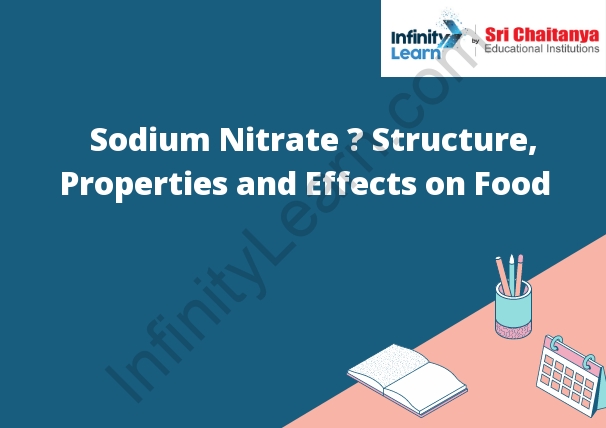Table of Contents
Sodium Nitrate – NaNO3
Sodium Nitrate – Structure:
Sodium nitrate is a white or slightly yellowish crystalline solid that is soluble in water. It is a salt composed of sodium and nitrate ions. The nitrate ion is a powerful oxidizing agent.
Sodium nitrate is used in the manufacture of explosives, dyes, and other chemicals. It is also used as a food preservative and in fertilizers.

What is Sodium Nitrate?
Sodium nitrate is a chemical compound with the formula NaNO 3 . It is a white solid that is very soluble in water. It is produced by the reaction of nitric acid and sodium hydroxide. Sodium nitrate is used in the production of fertilizers, explosives, and dyes.
Structure of Sodium Nitrate
- Sodium nitrate is a white, crystalline, water-soluble compound with the formula NaNO 3 . It is the sodium salt of nitric acid. Sodium nitrate is used in fertilizers, explosives, and in the manufacture of glass and pottery.
- The molecular structure of sodium nitrate is shown below.
- The sodium atom is shown in pink and the nitrate (NO 3 ) ion is shown in green. The sodium atom is covalently bonded to the nitrate ion.
Preparation of Sodium Nitrate
A mixture of sodium hydroxide and nitric acid is used to produce sodium nitrate. The sodium hydroxide is added to the nitric acid to produce a sodium nitrate and water solution. The sodium nitrate is then purified by a series of filtrations.
Properties of Sodium Nitrate
The main use of sodium nitrate is as a fertilizer. It is also used in the production of explosives, glass, and other chemicals. Sodium nitrate is a white or light yellow crystalline solid that is slightly soluble in water. It is a good conductor of electricity.
Physical Properties
- The physical properties of gold are its color, malleability, and ductility.
- Gold is a yellow metal that is very malleable, meaning it can be hammered into thin sheets. It is also ductile, meaning it can be drawn into thin wires.
- These physical properties make gold easy to work with and popular for jewelry and other decorative items.The physical properties of magnesium are:
- Magnesium is a silver-white, light metal.
- It is a good conductor of heat and electricity.
- Magnesium is not corroded by air or water.
- Magnesium is not magnetic.
Chemical Properties
- Sodium nitrate is a colorless, odorless, and slightly bitter-tasting crystalline solid that is soluble in water. It is an ionic compound consisting of sodium (Na+) ions and nitrate (NO3−) ions. Sodium nitrate is used in the manufacture of explosives, fertilizers, and dyes. It is also used as a food preservative.
- Sodium nitrate is a salt of nitric acid. The nitrate ion (NO3−) is a polyatomic ion made up of one nitrogen atom and three oxygen atoms. The sodium ion (Na+) is a monatomic ion made up of one sodium atom.
- The chemical formula for sodium nitrate is NaNO3.
- Sodium nitrate is a white crystalline solid that is soluble in water. It is an ionic compound consisting of sodium (Na+) ions and nitrate (NO3−) ions.
- Sodium nitrate is used in the manufacture of explosives, fertilizers, and dyes. It is also used as a food preservative.
Sodium Nitrate in Food
Sodium nitrate is a common food additive that is used to preserve color and flavor in meats, cheeses, and other foods. It is also used in some fertilizers. Sodium nitrate is generally safe to eat in small amounts, but large doses can be harmful.
Effect of Sodium Nitrate on Plant Growth
The effect of sodium nitrate on plant growth is an increase in plant growth. Sodium nitrate is a source of nitrogen, which is a nutrient that is essential for plant growth. When sodium nitrate is added to the soil, it increases the availability of nitrogen, which results in an increase in plant growth.
Application Process of Sodium Nitrate
The process of making sodium nitrate begins with the mining of sodium chloride, or salt. The salt is then dissolved in water and combined with ammonia. The solution is then heated until the sodium nitrate crystallizes out. The crystals are then filtered out and dried.
Uses of Sodium Nitrate
The most common use of sodium nitrate is as a food preservative. It is also used in fertilizers, explosives, and in the manufacture of dyes and pigments.








